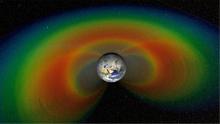This artist's concept shows a possible design for a future Mars habitat, created on the Martian surface with 3D printing. Any human habitat will need to be shielded from solar radiation and cosmic rays. A recent study found that astronauts would be exposed to high doses of X-rays during the trip to and from Mars. Mars has no global magnetic field and only a thin atmosphere to protect people on the surface. [NASA/SEArch+/Apis Cor]
You are here
Moon and Mars
A trip to Mars takes a while — with current rockets, about six months to get there and six months to get back. And thanks to the alignment of the planets, the layover between flights is a year or so.
All of that time in space and on Mars would expose astronauts to large doses of radiation. According to a European spacecraft, they’d be exposed to the equivalent of about 6,000 chest X-rays just during the round trip. Their time on Mars would add even more.
We don’t have to worry about space radiation here on Earth — we’re protected by the planet’s magnetic field and its atmosphere. The magnetic field also offers some protection to astronauts in Earth orbit.
Outside that field, though, crews would be exposed to solar storms, and to cosmic rays, which come from outside the solar system.
No one is sure how the radiation would affect astronauts — there aren’t enough studies. But they could suffer from radiation sickness, higher chances of cancer, or other problems.
NASA and others are looking at ways to protect Mars travelers. They’re trying to develop lightweight shielding, for example, or Star Trek-like force fields. And they’re studying ways to enhance a person’s resistance to radiation — everything from gene therapies to suspended animation. So far, though, there are no good solutions to the problem of space radiation.
Mars is in great view tonight. The planet looks like a bright star just above the Moon as night falls.
Script by Damond Benningfield
Get Premium Audio
Listen to today's episode of StarDate on the web the same day it airs in high-quality streaming audio without any extra ads or announcements. Choose a $8 one-month pass, or listen every day for a year for just $30.






